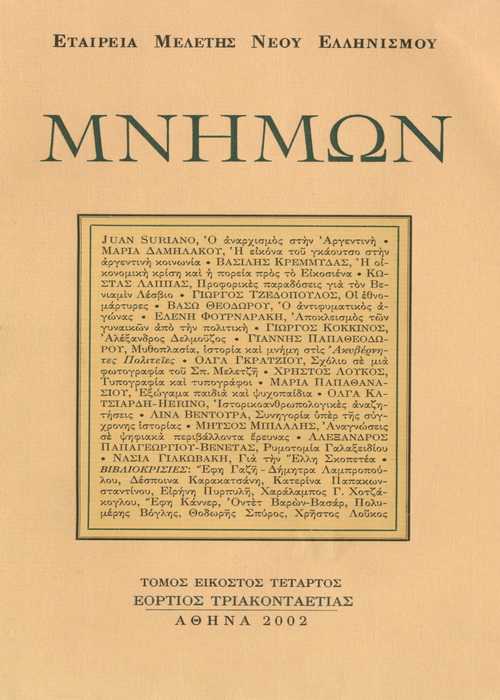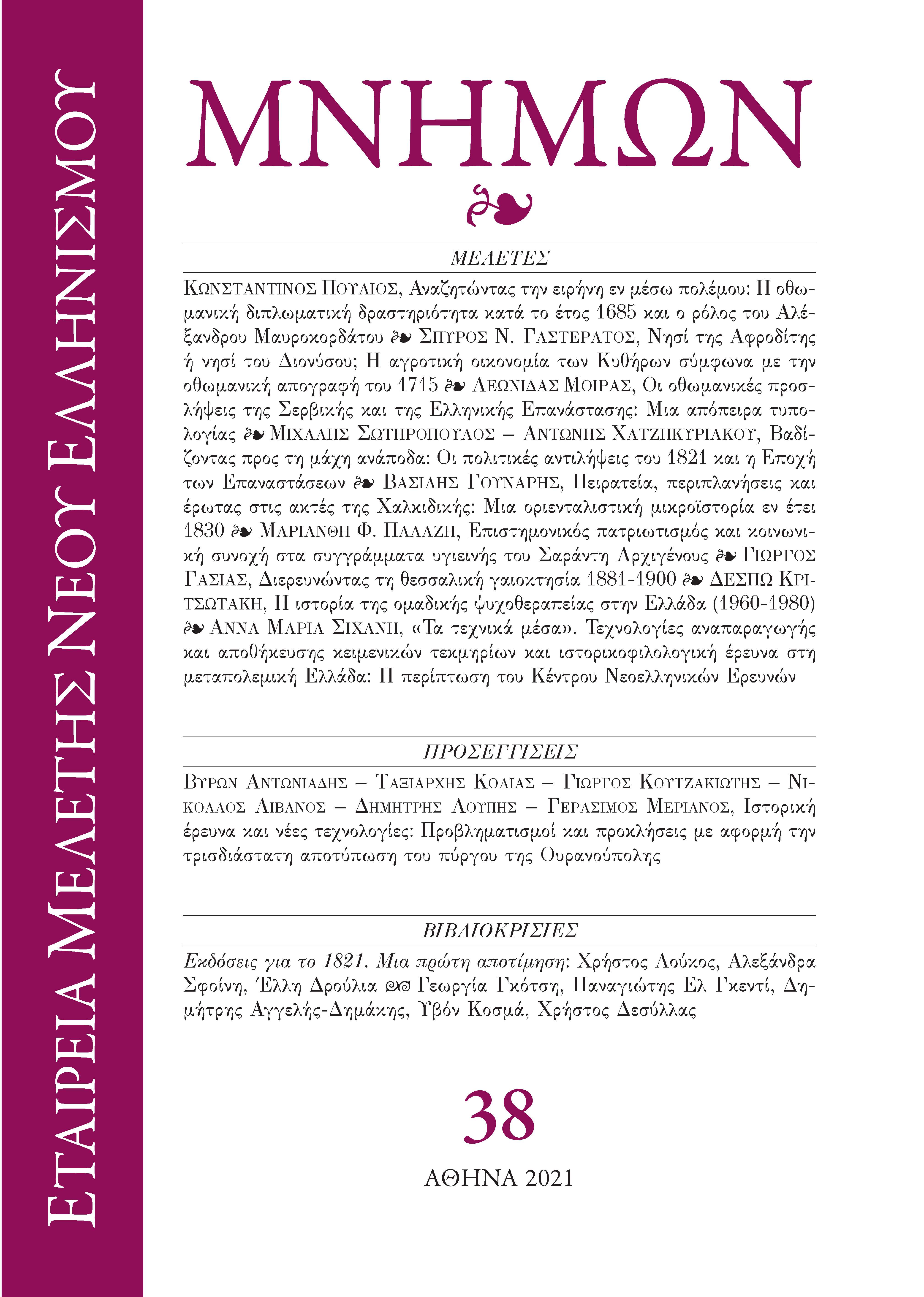ΜΕΤΑΝΑΣΤΕΥΣΗ ΚΑΙ ΑΣΤΙΚΟΠΟΙΗΣΗ. Η ΕΓΚΑΤΑΣΤΑΣΗ ΤΩΝ ΕΥΡΩΠΑΙΩΝ ΜΕΤΑΝΑΣΤΩΝ ΣΤΗΝ ΠΟΛΗ ΤΟΥ ΜΠΟΥΕΝΟΣ ΑΪΡΕΣ (1880-1920)
Περίληψη
Maria Damilakou, Immigration and Urbanisation. The Settlement of European Immigrants in the City of Buenos Aires (1880-1920)
The present article is based on the national census of Argentina as wellas on the municipal census of the city of Buenos Aires, during the period 1869-1914; it aims to illuminate certain aspects of the mutual relationship developed between the immigrants' action and the urban space where they were called to settle in. The choices of housing and the «routes» of the different ethnic groups in the neighbourhoods and suburbs of the city were inserted in a wider context, defined by structural factors related to work, social hierarchies and urban space's organization. However, this context did not exist independently from the immigrants' action: their cultural characteristics, desires and decisions were constantly creating new conditions that contributed to the successive transformations of Buenos Aires' urban network. The map of the different settlements of the ethnic groups in the city of Buenos Aires reveals, on the one hand, the absence of closed ghettoes and exclusive neighbourhoods and, on the other hand, the tendency of the ethnic groups to be concentrated in certain zones; these tendencies oblige us to moderate both the image of an harmonic coexistence of all immigrants, as well as the model based on the existence of clear boundaries among ethnic groups, accordingly to their position in the social hierarchies. Many and varying factors seem to have conditioned the settlement patterns of ethnic groups: the great number and the early arrival of Italian and Spanish immigrants contributed to their dispersion all over the city, whereas smaller ethnic groups such as the Portuguese and the British, tended to be more concentrated in certain neighbourhoods. The remarkable concentration of certain groups, such as the French and the British, was also due to their high socio-economic level; Finally, the cohesion of latter immigrant groups —Russian Jews, Syrianand Lebanese— could be attributed to their cultural particularity incomparison to the host society. However, the map of the settlements of the ethnic groups was not a static one but was constantly changing: since the beginning of the 20th century until 1914, one could observe a high mobility towards the city's periphery, related to the access to the proper house, which determined the city's expansion patterns. The immigrants' action in the suburbs determined not only Buenos Aires' urbanisation process but also the architecture and the neighbourhoods' style. Despite the decisive role of mass transports' expansion and the opportunities offered by the landmarket, immigrants' mobility towards the suburbs can not be conceived independently of the ethnic social networks through which many immigrants followed the steps of their parents and fellow countrymen. Besides, the role of the argentine state in the housing problem was limited: the attempt to create some state subsidized houses in the periphery had very relative results and the poor suburbs were mostly inhabited through more «spontaneous» mechanisms, based on the ethnic social networks.
Λεπτομέρειες άρθρου
- Πώς να δημιουργήσετε Αναφορές
-
ΔΑΜΗΛΑΚΟΥ Μ. (2004). ΜΕΤΑΝΑΣΤΕΥΣΗ ΚΑΙ ΑΣΤΙΚΟΠΟΙΗΣΗ. Η ΕΓΚΑΤΑΣΤΑΣΗ ΤΩΝ ΕΥΡΩΠΑΙΩΝ ΜΕΤΑΝΑΣΤΩΝ ΣΤΗΝ ΠΟΛΗ ΤΟΥ ΜΠΟΥΕΝΟΣ ΑΪΡΕΣ (1880-1920). Μνήμων, 26, 95–131. https://doi.org/10.12681/mnimon.835
- Τεύχος
- Τόμ. 26 (2004)
- Ενότητα
- ΜΕΛΕΤΕΣ
Οι συγγραφείς των άρθρων που δημοσιεύονται στο Μνήμονα διατηρούν τα δικαιώματα πνευματικής ιδιοκτησίας επί των άρθρων τους, δίνοντας στο περιοδικό το δικαίωμα της πρώτης δημοσίευσης. Άρθρα που δημοσιεύονται στο Μνήμονα μπορούν να χρησιμοποιούνται ελεύθερα, χωρίς δικαίωμα τροποποίησης (δημιουργία παράγωγου έργου) με αναφορά στο συγγραφέα και στην πρώτη δημοσίευση για μη κερδοσκοπικούς σκοπούς(άδεια Creative Commons 4.0). To Εθνικό Ίδρυμα Ερευνών διατηρεί το δικαίωμα να δημοσιεύει, να αναπαραγάγει, να παρουσιάζει στο κοινό, να διανέμει και χρησιμοποιεί άρθρα που δημοσιεύονται στο Μνήμονα σε οποιοδήποτε μέσο και μορφή είτε μεμονωμένα είτε ως μέρη συλλογικών έργων, για όλο το χρόνο διάρκειας προστασίας της πνευματικής ιδιοκτησίας και για όλες τις χώρες του κόσμου. Αυτό περιλαμβάνει ενδεικτικά και όχι αποκλειστικά, το δικαίωμα δημοσίευσης των άρθρων σε τεύχη του περιοδικού Μνήμων, αναπαραγωγής και διανομής μεμονωμένων αντιγράφων των άρθρων, αναπαραγωγής ολόκληρων των άρθρων σε άλλη έκδοση του ΕΙΕ, και αναπαραγωγής και διανομής των άρθρων ή περίληψης αυτών με χρήση πληροφορικού συστήματος αποθετηρίου.





